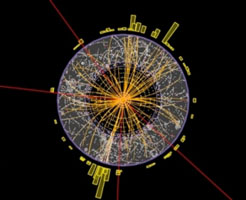The 2013 Nobel Prize in Physics to François Englert and Peter Higgs cites not only their theoretical discovery but its confirmation “through the discovery of the predicted fundamental particle, by the ATLAS and CMS experiments at CERN’s Large Hadron Collider.”
 “The prediction and subsequent discovery of the Higgs boson is a fascinating chapter in the history of science, and a powerful testament to human imagination, innovation, perseverance, and international cooperation,” says Natalie Roe, Director of the Physics Division at the U.S. Department of Energy’s Lawrence Berkeley National Laboratory (Berkeley Lab). “The Nobel prize for Englert and Higgs is well deserved, and a wonderful way to celebrate this incredible scientific journey.”
“The prediction and subsequent discovery of the Higgs boson is a fascinating chapter in the history of science, and a powerful testament to human imagination, innovation, perseverance, and international cooperation,” says Natalie Roe, Director of the Physics Division at the U.S. Department of Energy’s Lawrence Berkeley National Laboratory (Berkeley Lab). “The Nobel prize for Englert and Higgs is well deserved, and a wonderful way to celebrate this incredible scientific journey.”
U.S. scientists contributed to the underlying theory, and also provide substantial ongoing support to the Large Hadron Collider and especially the experiments that made the Higgs discovery, including a third of the CMS Collaboration and almost a fourth of the ATLAS Collaboration. One of the largest groups in the U.S. ATLAS contingent, with more than 40 active members, comes from Berkeley Lab and is led by Ian Hinchliffe. It includes students, postdocs, UC faculty, and Berkeley Lab staff.
“We’re delighted that the Nobel Prize Committee has recognized this important work and recognized the critical role of the experiments in confirming the fine predictions by Englert and Higgs and their colleagues,” says Hinchliffe. In fact, he says, there would have been no Nobel Prize had “we experimenters not made the discovery that proved the theorists were right.”
Hinchliffe emphasizes the important contributions Berkeley Lab has made to the ATLAS experiment, beginning with its construction, its software design and implementation, and its ongoing operations and physics analyses. With Kevin Einsweiler, Gil Gilchriese led the Berkeley Lab team that assembled and tested some of the ATLAS Inner Detector’s most advanced elements, including the pixels and silicon strips and their electronics. Beate Heinemann is currently ATLAS Deputy Spokesperson and Einsweiler just completed his term as physics coordinator for ATLAS. A group of computing experts led by Paulo Calafiura of the Computer Research Division plays a critical role in software support.
The Engineering and Accelerator and Fusion Research Divisions have also fulfilled vital functions in both ATLAS and the Large Hadron Collider itself. The discovery of the Higgs boson, and the Nobel Prize resulting from that discovery, are just the beginning of exploration and discovery at the LHC.
“LHC operations will resume in 2015 at a much higher energy,” says Hinchliffe. “We’re looking for more exciting results to roll in.”
Go here for more about U.S. participation in the Higgs discovery, here for more about Berkeley Lab’s role in ATLAS and the search for the Higgs, and here for future contributions to the LHC by Berkeley Lab and other DOE Labs.